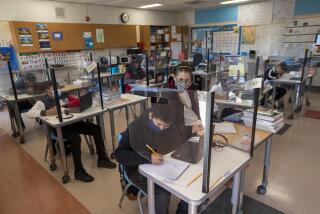All-Year Sessions Possible for Some
- Share via
LONG BEACH — School Supt. E. Tom Giugni says he plans to deal with a looming enrollment crisis in the Long Beach Unified School District by, among other things, asking the Board of Education to institute year-round schools beginning in the fall, 1987.
“I know it can work and I know it can be good for the community and the students,” Giugni said following a daylong workshop last week during which he announced some of his plans for the coming year.
Assistant Supt. Charles Carpenter, who has been instructed by Giugni to prepare a formal proposal for consideration by the board this fall, added: “It’s our good-faith effort to cope with growing enrollment.”
If adopted, Carpenter said, the plan would begin with four or five as-yet unspecified elementary schools as a prelude to eventual implementation districtwide. “(That way) we could get the bugs out of the system before the crunch hits,” he said.
Although the idea of year-round schools has long been discussed on an administrative level, said school board President John Kashiwabara, it has never been implemented in Long Beach. The subject came up last week at the workshop, where staff and board members talked about a number of solutions to what they have described as an impending disaster of over-enrollment in Long Beach.
2,200 Enrollment Increase
School officials say they expect the district’s 1985-86 enrollment of 64,000 students to increase by 2,200 in September. By 1987, they say, the district will need 72 more classrooms for its projected student population.
Carpenter estimates that the year-round operation of schools would increase the district’s capacity by 20% to 25%. Although such a plan would not solve all of the district’s enrollment problems, officials say, it could be effective in conjunction with a number of other options being considered by the district. (See related story.)
Although a number of models for year-round schools exist, Carpenter said, he is leaning toward a plan that would divide students at participating schools into four groups, each of which would attend class on a staggered cycle of 60 days on, 20 days off. Initially, according to Giugni, the plan would be voluntary, with those unwilling to participate having the option of transferring their children to neighboring schools unaffected by the plan.
Carpenter said he has not yet arrived at an estimated cost of operating schools year-round. Included, he said, would be the extra cost of air conditioning during the summer, the increase in necessary teaching and support staff and the cost of opening and closing school sessions throughout the year rather than just in June and September.
He said there is also a one-time state grant of $25,000 for districts converting one or more schools to year-round operation, and a state incentive of $25 per year per pupil enrolled in year-round programs.
Unpopular Among Some Parents
Yet the concept--which has been implemented in several neighboring districts including Los Angeles, Santa Ana and Montebello--has proved unpopular among some parents who have said it disrupts family vacation plans and deprives youngsters of summer activities.
At least one board member seemed to share those concerns. “My first inclination would be to avoid it,” said James Zarifes. “I think that kids ought to do something in the summer other than go to school.”
Other board members had mixed reactions to the idea, with Harriet Williams enthusiastic and Kashiwabara saying he was open-minded on the issue but had some questions regarding how it would work.
State law requires the board to formally announce its intentions regarding the matter by Nov. 1 in order to implement the plan at the beginning of the next school year. Following that, a public hearing would be held. According to the state Education Code, a petition signed by 25% of the voters and a subsequent election could prevent the establishment of year-round schools.
More to Read
Sign up for Essential California
The most important California stories and recommendations in your inbox every morning.
You may occasionally receive promotional content from the Los Angeles Times.













